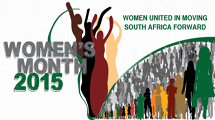By Minister Faith Muthambi
[[{"type":"media","view_mode":"media_large","fid":"410672","attributes":{"class":"media-image","id":"1","style":"margin: 3px; float: left;;","typeof":"foaf:Image"}}]]On August 9 1956, about 20 000 women of all races sang “Wathint`abafazi, Strijdom!” (You Have Struck a Woman!) as they arrived at the Union Buildings. Although the protest focussed on discriminatory pass laws, it was a concrete affirmation that the struggle for liberation would not be won without women activism.
The actions by this group of heroic women set the tone for gender equality and empowerment in a democratic South Africa. Twenty one years into our democracy their bravery still echoes in every aspect of our lives and it is clear that we will never be totally free until there is gender parity at all levels of society.
Due to the sacrifices of these brave women we now live in a country governed by legislation which ensures that women enjoy the same rights as their male counterparts in education, employment, property, inheritance and justice.
Over the past 21 years the government has also implemented numerous policies and initiatives to uplift women and help them reach the pinnacle of success. Today it is not uncommon to see women breaking through glass ceilings and excelling in every field, and every time it happens we like to believe that it reassures a girl somewhere in South Africa that she too can reach the top.
One of the most important partners in spread the word about women succeeding is the media. However, too often only women’s publications report on these achievements while mainstream publications tend to give prominence only in supplements or so-called pages dedicated to women.
This is borne out by a Media Tenor SA report, “A Woman in a Man’s World” (2013), which points to the fact that issues related to women are consistently under-reported across media.
Media might have come a long ways since being unshackled in 1994 but its transformation process is far from complete. This is confirmed by the “State of the Newsroom South Africa 2014” report released by Wits University’s Journalism Department, which has revealed that both gender representation in the boardroom and newsroom are still far from reaching parity.
The report has found that 12 out of 43 editors were female (28%). A further breakdown shows that only six were black women (14%).
It is also disappointing to note that since their 2013 report there was a decline in the number of women editors in the print media sector. The 2014 report notes: “The number of women who sit on the boards of big media companies remains at a grim 4% from the 2012-2013 period.”
The latest Wits findings are in line with a Print and Digital Media Transformation Task Team report (2013), which at the time pointed out: “The position of blacks generally and black women in particular in the management and control of companies as well as in the boardrooms is dismal.”
To change this situation around various role players, including Sanef, have partnered to launch a Women in News programme in 2014. This five month-long educational programme aims to equip female media professionals in middle management positions with strategic skills and support networks to take on greater leadership roles within their organisations.
Transformation is not only about numbers, but also attitude towards women in top management structures. Senior lecturer at Wits Journalism Dr Glenda Daniels highlighted in The Media that “women do not have an easy time because they are judged as women editors”.
Sunday Times editor Phylicia Oppelt confirmed this and insists to being judged on merit. “Interrogate my past performance, the jobs that I have done. If what I have contributed to the newspapers I have edited does not merit this appointment, then I should not have got this job. I doubt my predecessors have been interrogated in the same manner,” she states.
The other challenge is that a woman as an editor is often a bigger story that her journalism skills. Ferial Haffajee once stated that in 2004, when she became Mail & Guardian editor, “the novelty value surprised me as it was my gender, not my journalism that caught attention”.
As the government we sincerely hope that transformation in our media will also translate in more gender balanced content and newspaper columns by women. Also, we would also like to see and hear more women voices in media. As a country we are in dire need of women experts giving their professional opinion in media about everything from construction to physics.
Our nation and media have come a long way since the 1956 women’s march. While women enjoy equal rights, gender transformation and attitudes towards women in top structures are ongoing processes. Let us move South Africa forward by empowering women in and through media.
Faith Muthambi is the Minister of Communications.





